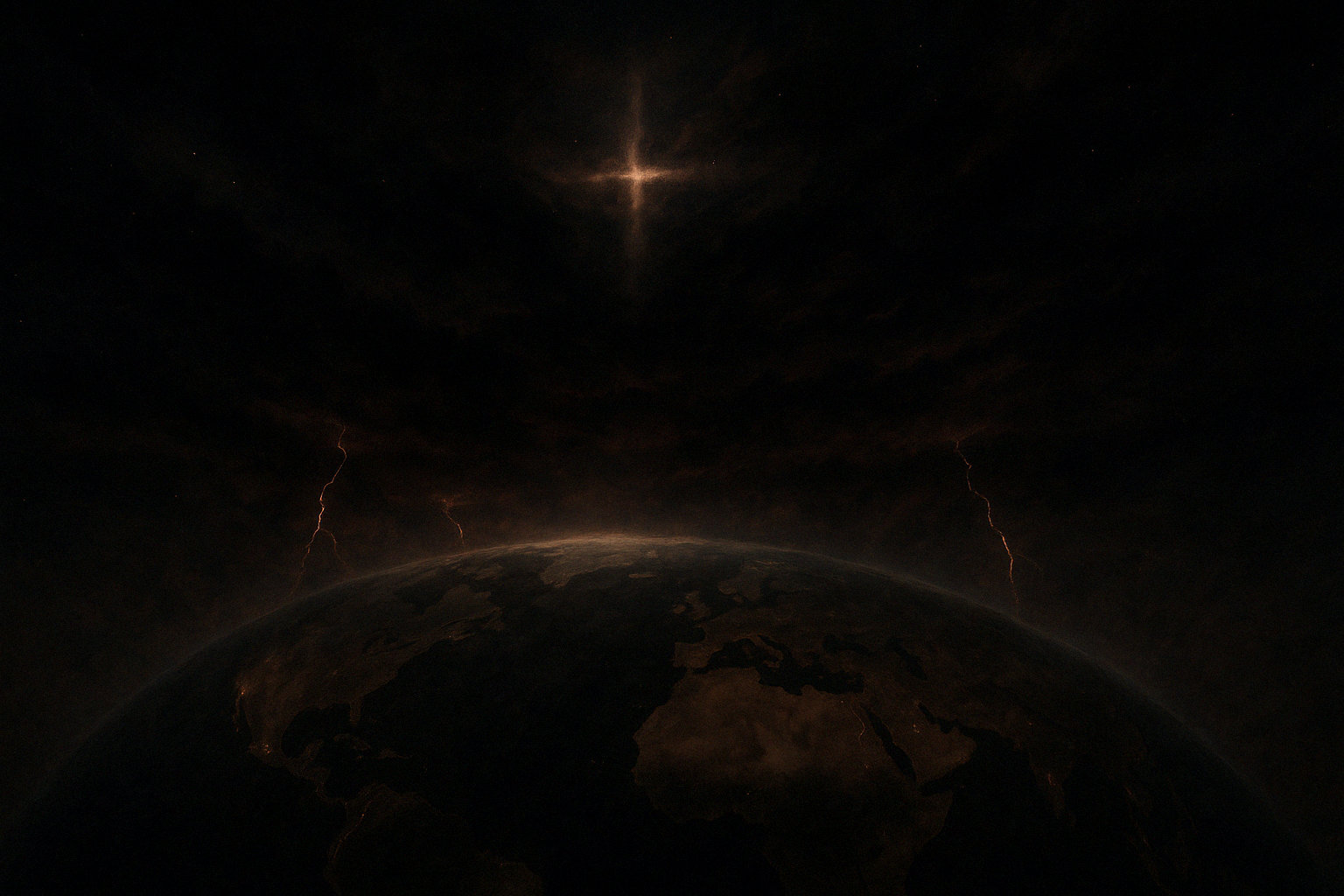Darkness occurred during the crucifixion of Jesus for three hours. This was not an eclipse; this was darkness. Was this a local event or worldwide?
Introduction
The crucifixion of Jesus Christ, traditionally dated around AD 30–33, is one of the most significant events in human history. The Gospels of Matthew, Mark, and Luke all record an extraordinary event that occurred during Christ’s death: a profound darkness fell over the land from the sixth to the ninth hour (roughly noon to 3 PM). This mysterious phenomenon has long intrigued theologians, historians, and scientists alike. Was this darkness confined to Jerusalem, or did it leave an imprint on cultures and chronicles beyond Judea? A survey of global oral traditions, historical accounts, and mythological parallels reveals a compelling tapestry of testimonies pointing to an event of cosmic significance.
Ancient Roman and Greek Sources
Among the earliest non-Christian writers to mention the crucifixion darkness is Thallus, a historian writing around AD 52. Although his original works are lost, Julius Africanus, writing in the early third century, references Thallus’s explanation of the darkness as a solar eclipse. Africanus refutes this claim, correctly noting that Passover occurs during a full moon, making a solar eclipse astronomically impossible (Africanus, “Chronography” 18.1). Similarly, the Greek historian Phlegon of Tralles, writing in the second century, reported a “great eclipse” during the reign of Tiberius Caesar. He noted that the event occurred at the sixth hour and was accompanied by an earthquake, details that align closely with Gospel accounts (Origen, Against Celsus, 2.33).
Tertullian, an early Christian apologist writing in the late second century, claimed that the darkness was recorded in Roman archives, suggesting the event was visible and notable across the empire. He writes in Apologeticus 21: “You yourselves have the account of the world portent still in your archives.”
Ancient Chinese Records
In ancient China, astronomical events were meticulously recorded. The Book of the Later Han includes entries from the reign of Emperor Guangwu that describe a profound celestial disturbance: “Yin and Yang were mistakenly switched, and the sun and the moon were eclipsed. The sins of all the people are now on one man. Pardon is proclaimed to all under heaven” (Hou Han Shu, Vol. 1). Another entry notes, “Eclipse on the day of Guihai, Man from Heaven died” (Annals No. 18). These records date from around the time of Jesus’ crucifixion and reflect a deeply moral interpretation of the event.
Peruvian and South American Traditions
In the Andes, the Huarochirí Manuscript, a 17th-century document preserving pre-Incan oral traditions, recounts a time when the sun disappeared for five days, and chaos reigned. People were attacked by animals, stones clashed against each other, and the natural world turned hostile. While this story is mythologized, it is tied to a real memory of a solar absence and bears thematic similarities to the biblical darkness.
Another legend speaks of a radiant white man arriving from Lake Titicaca, performing miracles, and transforming the landscape. Revered as the maker of all things, this figure may reflect the Incan memory of a divine visitation, interpreted by Christian missionaries as a prefiguration of Christ.
Mythological Parallels
In Greek mythology, Prometheus—the titan who brought fire to mankind—was crucified on Mount Caucasus, nailed with outstretched hands. During his torment, the earth shook, skies darkened, and thunder echoed through the heavens. While composed centuries before Christ, the parallels between Prometheus’ suffering and Jesus’ crucifixion have long been noted as a form of prophetic typology.
Norse mythology contains similar pre-Christian echoes. Odin, the chief god, sacrificed himself by hanging on Yggdrasil, the world tree, pierced by a spear for nine days. Though no darkness is described, the symbolism—suffering, hanging, and piercing—resonates with the crucifixion account.
Egyptian and Middle Eastern Observations
Pseudo-Dionysius the Areopagite, a later Christian writer, recounts witnessing the event from Heliopolis, Egypt. In his account, the moon oddly obscured the sun in a pattern unnatural to standard eclipses. This may reflect the attempt of ancient astronomers to rationalize a supernatural occurrence.
Josephus, the Jewish historian, while not clearly referencing Jesus’ crucifixion, speaks of the sun’s darkening in response to wicked acts. This likely refers to Caesar’s assassination rather than the crucifixion, yet it shows the cultural expectation that such crimes elicited cosmic signs.
Celtic and European Legends
Ireland preserves a compelling legend involving King Conor Mac Nessa. Suffering from a cranial injury, he lived cautiously until hearing—somehow in real time—of Jesus’ crucifixion. Overcome with rage, he attempted to avenge Christ but died when the pressure dislodged the object in his head. His druid advisor declared the existence of one God and recounted Christ’s death, suggesting a miraculous, divinely inspired revelation.
Likewise, the story of King Clovis of the Franks, who converted to Christianity in the 5th century, includes a dramatic declaration: “If I had been there with my valiant Franks, I would have avenged Him.” Though symbolic, it illustrates the intense emotional impact of the crucifixion narrative across cultures.
Scientific and Geological Evidence
In 2012, a geological study published in the International Geology Review identified sediment disruption in the Dead Sea region that aligns chronologically with the crucifixion. The researchers concluded that a major earthquake occurred between AD 26–36, consistent with the Gospels’ report of seismic activity during Christ’s death (Williams et al.).
Conclusion
Though not every account reviewed is historically verifiable in the modern empirical sense, the convergence of global traditions—from Chinese imperial records and Roman commentaries to Andean myths and Celtic legends—speaks to the widespread recognition of a momentous event at the time of Jesus’ crucifixion. Whether natural or supernatural, the darkness recorded in so many forms suggests a global echo of the sorrow and severity of the day Christ died.
Works Cited
- Africanus, Julius. Chronography, 18.1. Quoted in George Syncellus, Chronographia.
- Origen. Against Celsus. Translated by Frederick Crombie, vol. 4, T&T Clark, 1869.
- Tertullian. Apologeticus. Translated by S. Thelwall, Ante-Nicene Fathers, vol. 3, Christian Literature Publishing Co., 1885.
- Hou Han Shu [Book of the Later Han]. Vol. 1 and Annals No. 18.
- Leon, Pedro Siesa de. The Second Part of the Chronicle of Peru. Translated by Clements R. Markham, Hakluyt Society, 1883.
- Huarochirí Manuscript. Translated by Frank Salomon and George L. Urioste, University of Texas Press, 1991.
- Williams, Jefferson B., et al. “An Early First-Century Earthquake in the Dead Sea.” International Geology Review, vol. 54, no. 10, 2012, pp. 1211–1222.
- Dionysius the Areopagite. Letter to Polycarp. Quoted in Jean Hardouin, Acta Martyrum.
- Gibbon, Edward. The History of the Decline and Fall of the Roman Empire. Vol. 2, 1781.
- Pliny the Elder. Natural History. Translated by H. Rackham, Loeb Classical Library, 1938.
- Josephus, Flavius. Wars of the Jews. Translated by William Whiston, 1737.
- Rufinus of Aquileia. Commentarius in Symbolum Apostolorum. Translated by Philip Schaff, Nicene and Post-Nicene Fathers, vol. 3.





